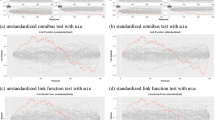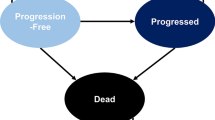Abstract
In this paper, we propose a new class of semi-parametric cure rate models. Specifically, we construct dynamic models for piecewise hazard functions over a finite partition of the time axis. Allowing the size of partition and the levels of baseline hazard to be random, our proposed models provide a great flexibility in controlling the degree of parametricity in the right tail of the survival distribution and the amount of correlations among the log-baseline hazard levels. Several properties of the proposed models are derived, and propriety of the implied posteriors with improper noninformative priors for regression coefficients based on the proposed models is established for the fixed partition of the time axis. In addition, an efficient reversible jump computational algorithm is developed for carrying out posterior computation. A real data set from a melanoma clinical trial is analyzed in detail to further demonstrate the proposed methodology.



Similar content being viewed by others
References
Arjas E, Gasbarra D (1994) Nonparametric Bayesian inference from right censored survival data, using the Gibbs sampler. Stat Sinica 4:505–524
Aslanidou H, Dey DK, Sinha D (1998) Bayesian analysis of multivariate survival data using Monte Carlo methods. Canad J Stat 26:33–48
Berkson J, Gage RP (1952) Survival curve for cancer patients following treatment. J Am Stat Assoc 47:501–515
Chen MH, Ibrahim JG, Sinha D (1999) A new Bayesian model for survival data with a surviving fraction. J Am Stat Assoc 94:909–919
Chen MH, Shao QM (1999) Monte Carlo estimation of Bayesian credible and HPD intervals. J Comp Graph Stat 8:69–92
Cowles MK, Carlin BP (1996) Markov chain Monte Carlo convergence diagnostics: a comparative review. J Am Stat Assoc 91:883–904
Gamerman D (1991) Dynamic Bayesian models for survival data. Appl Stat 40:63–79
Green PJ (1995) Reversible jump Markov chain Monte Carlo computation and Bayesian model determination. Biometrika 82:711–732
Gilks WR, Wild P (1992) Adaptive rejection sampling for Gibbs sampling. Appl Stat 41:337–348
Ibrahim JG, Chen MH, Sinha D (2001a) Bayesian semi-parametric models for survival data with a cure fraction. Biometrics 57:383–388
Ibrahim JG, Chen MH, Sinha D (2001b) Bayesian survival analysis. Springer-Verlag, New York
Maller R, Zhou X (1996) Survival analysis with long-term survivors. John Wiley and Sons, New York
McKeague IW, Tighiouart M (2000) Bayesian estimators for conditional hazard functions. Biometrics 56:1007–1015
Tighiouart M (2003) Modeling correlated time-varying covariate effects in a Cox-type regression model. J Modern Appl Stat Meth 2:161–167
Tsodikov AD, Ibrahim JG, Yakovlev AY (2003) Estimating cure rates from survival data: an alternative to two-component mixture models. J Am Stat Assoc 98:1063–1078
Yakovlev AY, Tsodikov AD (1996) Stochastic models of tumor latency and their biostatistical applications. World Scientific, New Jersey
Acknowledgements
The authors wish to thank the Editor, the Associate Editor and three referees for helpful comments and suggestions which have led to an improvement of this article. Dr. Chen's research was partially supported by National Institute of Health (NIH) grant numbers GM 70335 and CA 74015.
Author information
Authors and Affiliations
Corresponding author
Appendix: Proofs of Properties and Theorem
Appendix: Proofs of Properties and Theorem
Proof of Property 2.1
From the definition of E(ξ j | λ0) given in (2.8), we have
Now using the definition of a derivative of the function \({H_0(\cdot)}\) and the assumption that \({\frac{s_j + s_{j-1}}{2} \rightarrow t}\), we have \({\lim_{s_j - s_{j-1} \rightarrow 0} E(\xi_j \vert \lambda_0) = \log ( \frac{\hbox{d}}{\hbox{d}t} H_0(t)) = \log h_0(t)}\). □
Proof of Property 2.2
Note that for \({t\in (s_{j-1}, s_j)}\),
where
As α → ∞, b j → 0 and c j → r for \({j = 1,2, \ldots, J}\). Thus, we have
and
Note that the right hand side of (A.1) equals H 0(t) when \({t \in \{s_1, s_2, \ldots, s_J\}}\) and for other values of t is only approximately equal in the sense that as \({s_j-s_{j-1}\rightarrow 0}\), the right hand side of (A.1) approaches H 0(t). Again,
where
with
Now letting α → ∞, we obtain
Thus,
This shows that H *(t| λ)→ H 0(t) in probability for \({t\in \{ s_1, \ldots, s_J\}}\) and that F *(t| λ) = 1−exp(−H *(t| λ))→ F 0(t| λ0) in probability. Thus, given θ, the random survival function S * p (t| λ) = exp[−θ F *(t| λ)] converges to exp[−θ F 0(t| λ0)] in probability as α → ∞. This convergence is exact for \({t\in \{s_1, \ldots, s_J\}}\) and approximate for other values of t. □
Proof of Property 2.3
Using (2.6), we have
and
Then the correlation of ξ j and \({\xi_{j-1}}\) is given by
Now letting α → 0, we obtain
Therefore,
Also letting α → ∞ gives
□
Proof of Theorem 3.1
In (2.1), summing out the unobserved latent variable N i yields
where θ i = exp(x i ′β). If ν i = 0, for \({i = 1, 2, \ldots, n}\), then
Thus, it suffices to prove the propriety of the posterior distribution for the case where ν i = 1. Let δ ij = 1 if j = j i and 0 otherwise. Then \({f(y_i\vert \lambda) = \lambda_{j_i} \exp \{ - [ \lambda_{j_i} (y_i - s_{j_i-1}) +}\sum_{g=1}^{j_i-1} \lambda_g (s_g-s_{g-1}) ] \}\) and \({ S(y_i\vert \lambda) = \exp\left\{ - \left[ \lambda_{j_i} (y_i - s_{j_i-1}) + \sum_{g=1}^{j_i-1} \lambda_g (s_g - s_{g-1}) \right] \right\}}\).
Since X * is of full rank, there exists \({i^\ast_1, \ldots, i^\ast_p}\) such that \({\nu_{i^{*}_1} = \nu_{i^{*}_2} = \ldots= \nu_{i^{*}_p} = 1}\), and \({X_p^{*}=(x_{i_1^*}, x_{i_2^*},\ldots, x_{i_p^*})'}\) is of full rank. We make the transformation \({u = (u_1, \ldots, u_p)' = X_p^{*} \beta}\). This linear transformation is a one-to-one. Thus, we have
Since s j-1 < y i_j ≤ s j , we have
where K 1 > 0.
Note that ξ j = log(λ j ), \(\xi_1 \vert W \sim N(\mu_1, b_1 W)\) and \(\xi_j \vert \xi_{j-1}, W \sim N(\mu_j + c_j(\xi_{j-1} - \mu_j), b_j W)\), for \(j = 2, 3, \ldots, J\). Let \(p^{*}(\beta, \xi, W, \lambda_0\vert D)= L(\beta, \xi\vert D) \pi^\ast(\xi, W, \lambda_0)\). Then, we have
where the vector 1 has all elements equal to one. It is easy to see that given that the prior distributions of W and λ0 are proper, the integral of the right hand side of (A.2) is finite. This completes the proof. □
Rights and permissions
About this article
Cite this article
Kim, S., Chen, MH., Dey, D.K. et al. Bayesian dynamic models for survival data with a cure fraction. Lifetime Data Anal 13, 17–35 (2007). https://doi.org/10.1007/s10985-006-9028-7
Received:
Accepted:
Published:
Issue Date:
DOI: https://doi.org/10.1007/s10985-006-9028-7




